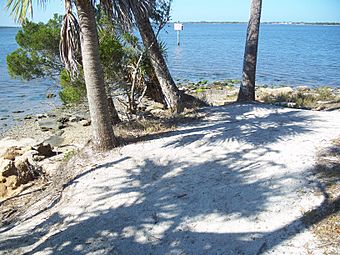Nocoroco facts for kids
Quick facts for kids |
|
|
Nocoroco
|
|
 |
|
| Nearest city | Ormond Beach, Florida |
|---|---|
| NRHP reference No. | 73000605 |
| Added to NRHP | May 7, 1973 |
Nocoroco is the site of an ancient Timucuan village. It is located on the Tomoka River, inside Tomoka State Park. This park is found a few miles north of Ormond Beach, Florida, on North Beach Street.
Contents
A Look Back in Time: Nocoroco's History
About 7,000 years ago, during a time called the Archaic Period, early people lived here. They found lots of fish and shellfish. The area was safe, protected by a barrier island to the east.
Around 1,200 years ago, the Timucuan people made this their home. Their descendants were still living here when Europeans arrived. In 1605, a Spanish explorer named Álvaro Mexía visited Nocoroco. By then, European culture was starting to influence the Timucuans. Mexia's trip explored the east coast of Florida for the Spanish governor.
Nocoroco was one of the last strongholds for the Timucuan people in northeast Florida. Today, all that remains of these native peoples are large piles of shells and other waste. These are called shell middens. They help modern archaeologists learn about how these people lived.
Changes Under New Rule
In 1763, Great Britain took control of Florida from Spain. The Nocoroco village site became part of a British land-grant. This land was called Mt. Oswald and belonged to Richard Oswald. His plantation grew crops like indigo and rice.
Florida went back to Spanish control in 1783. The area was likely farmed until many plantations were destroyed. This happened around 1835, at the start of the Second Seminole War.
What Archeologists Found at Nocoroco
The main part of the midden at Nocoroco is a dark earth layer. It has pockets of shells and some larger shell piles. This midden is different from most others in the area, which are mostly just shells.
The shells found include many types, like Crassostrea virginica (oysters) and Mercenaria mercenaria (clams). Other shells found were Tagelus plebeius, Arca sp., Donax variabilis, Geukensia demissa, Sinistrofulgur perversum, and Hexaplex fulvescens.
Animal bones were not well preserved and were often broken into small pieces. Deer bones were the most common food source. But bones from fish, turtles, and alligators were also found.
Nocoroco on the National Register
On May 7, 1973, Nocoroco was added to the National Register of Historic Places in the U.S.. This means it's an important historical site. It was listed because it can give us valuable information about early aboriginal history.
Nocoroco Today: The Tomokie Fountain
Today, a large fountain sculpture marks the site of the Nocoroco village. It is called the "Tomokie Fountain." Frederick Dana Marsh created this fountain.
The fountain shows his artistic idea of the legend of Tomokie. In the legend, Tomokie was very proud and drank from a sacred spring. Because of this, he and his whole group lost their lives. Information at the site says that stories about this legend are more than a hundred years old.



